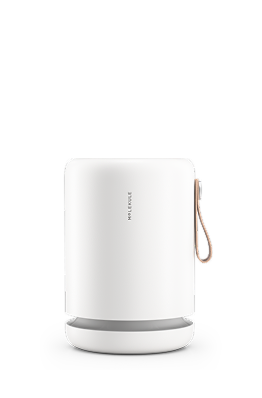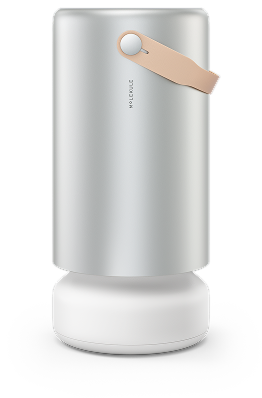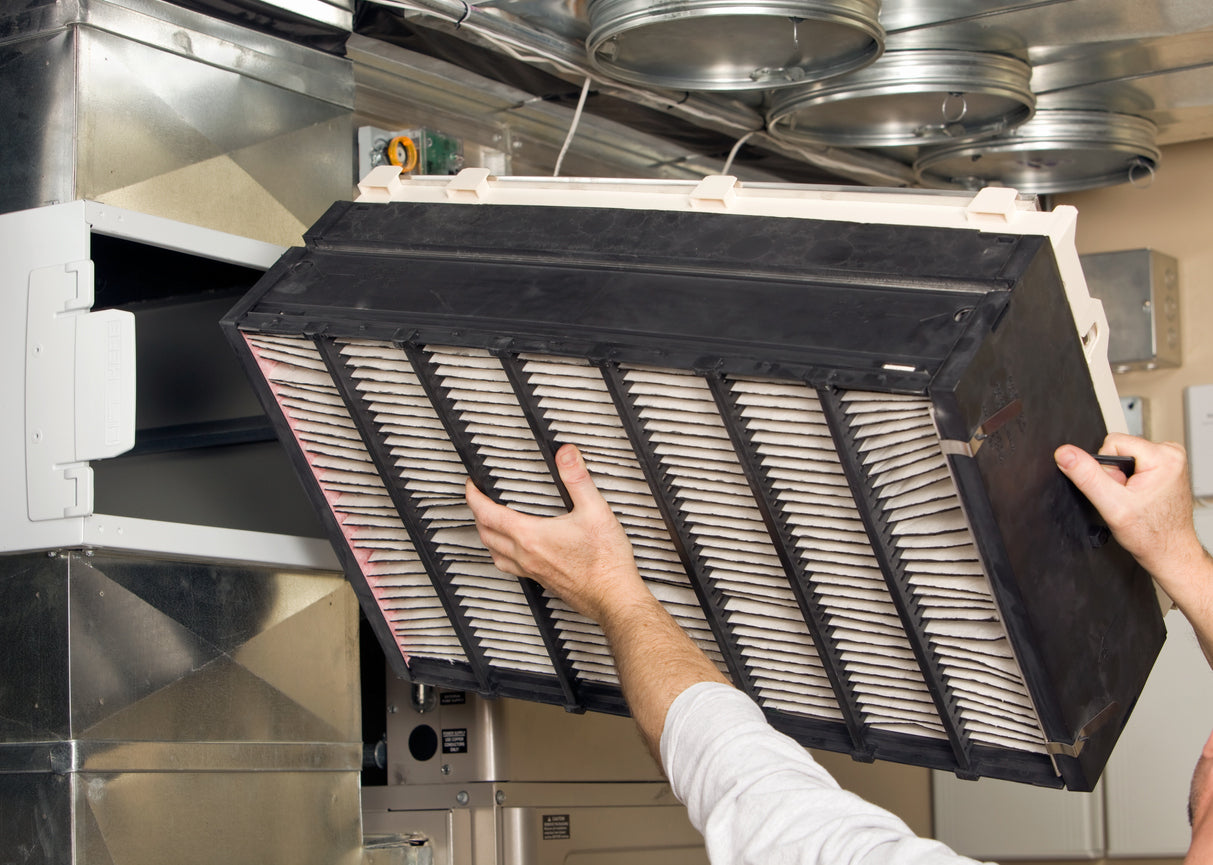When it comes to cleaning the air in a single room in your home, a portable air purifier is sufficient. But if you want to improve the indoor air quality throughout your entire house, a whole house air filter or purification system can clean the air as it passes through your home’s HVAC system. This will remove pollutants from the air throughout your home.
There is a lot of misinformation about “whole house” air purifiers—some air purifiers are marketed as such, but they are really just large portable units. While they may filter relatively more air, larger portable filters do not actually clean all the air in your house. A true whole house air purifier is built in to the HVAC system. It could be as simple as a filter where the air return enters the furnace (which is primarily intended to protect the furnace components from debris, rather than purifying the air), or it could be an electronic system built into the ductwork. To truly be considered a whole house air purifier, the filter needs to be placed into the airflow in the ductwork of your HVAC system.
Unfortunately, this also means that if you have an HVAC system that does not use forced air, such as a boiler or baseboard electric heat, whole house air purification is not really an option for you.
Duct-based systems
Whole house air purifiers built into the ductwork of your HVAC system generally come in two types: return air systems and supply air systems. The difference lies simply in where the path of your ducts the purifier is placed. A return air system is installed where air from the house is returned to the furnace, before it is heated or cooled. A basic replaceable media furnace filter, which typically costs between $30 to $50, depending on the brand name, is always found on the return side. A supply air system is placed between the furnace and the vent in the system, purifying the air before it is blown to the different rooms of your house.
All of these systems require some form of regular maintenance, whether it is changing the filter every few months or cleaning the collector plates annually—the level of inconvenience depends on how the filter was installed. Filters for a basement furnace are usually easy to get to and maintain. But if the filter is installed in a hard to access attic or crawlspace, maintenance will be significantly more difficult.
IQAir Perfect 16 – This purifier utilizes HEPA filters and needs to be professionally installed into ductwork, in the return air duct. It has a MERV 16 rating (a rating system for air filter efficiency in trapping small particles). However, it costs between $2,700 and $3,200, and replacement filters can cost as much as $400. Like many HEPA-based duct filters, the Perfect 16 might cause a pressure drop in the system that will cause problems for your HVAC system, and may require a more powerful or supplementary blower to maintain air movement through the system.
Moreover, this model only filters moving air, as in when the heat or air-conditioning is running (although most HVAC systems have a “fan on” mode that keeps air flowing through the ducts even when the heat or AC is not operating). The 3-ton and 5-ton versions of the Perfect 16 differ only in the amount of air that they can filter per minute. The “ton” labelling is misleading, as it does not refer to the weight of the unit (the 5-ton weighs under 80 lbs.), but to the weight of the air that passes through it in an hour of operation.
Amaircare 10,000 – Usually costing under $4,000, this HEPA-based, 3-stage filtration system requires professional installation in the return air duct and annual filter replacement. You can also get an optional upgrade to the third stage that adds a carbon filter for removing VOCs and other gaseous pollutants, but this VOC filter also needs to be changed every three months. And because it includes a powered fan to maintain proper air flow, the Amairicare 10,000 draws 600 watts of energy.
Beyond by Aerus G4 Whole Home Filtration – This system costs $1,999 and is mounted to ductwork, so it requires professional installation. It also uses three-stage filtration, composed of a pre-filter, HEPA filter and a carbon filter. Its powered fan moves and cleans air through the system 24/7, even when your HVAC is not on. The true HEPA filters in this unit should remove most particles, while the carbon portion of the filter, which needs changing every 6 to 10 months, will remove odors and VOCs. Like all the other HEPA-based systems, it has the advantage of not producing ozone, a toxic respiratory irritant.
Beyond by Aerus: Sanctuairy – This $1,500 system can be optionally installed to work with the G4 Whole Home Filtration system described above. However, Aerus’ vague description of its technology makes it difficult to understand exactly how this system works or its overall efficacy. The “ActivePure technology” that is described on their website seems to be an ozone generator, but the EPA recommends not using air purifiers that generate ozone in your home, whether intentionally or as a side effect. Ozone can reach toxic levels in your home, exacerbating allergy and asthma problems and even causing health problems for otherwise healthy people (Weschler, 2006).
Furnace filter systems
Honeywell Electronic Furnace Filter – Costing around $500, this system is also mounted into the ducts and requires professional installation. The filter uses “electrostatic precipitation” to remove particles from the air, and is combined with a pre and post filter. Electrostatic precipitation involves applying voltage to particles passing through the purifier, giving the particles a charge. The charged particles are then attracted to oppositely charged plates in the collection chamber (the “cells”). However there are two problems with this system: first, it requires significant maintenance, as the electrostatic plates and wires lose their effectiveness as they become dirty. Second, the voltage generates ozone as a side-effect, which can build up in small enclosed spaces, even in small amounts. This might be less of a problem in a whole house system, where ozone gets diffused throughout the entire house rather than concentrated in one room, but we still do not recommend sensitive individuals use an air purifier that generates any amount of harmful ozone.
Rheem RXIE-A14A – This is more expensive than the Honeywell system, but works in a similar manner.
AprilAire 5000 – Another electrostatic system that uses mechanical filters, the AprilAire 5000 costs $600 and requires annual maintenance as well as cleaning its internal electrodes. The manufacturer also suggests operating it with air always flowing through the HVAC system, which means you must keep the HVAC fan running even when the system is not heating or cooling.
Lennox PureAir – This system costs more than $1,300, not including installation. It has a MERV 16 rating due to its combination of filters and a UV-light-based PCO system that is designed to remove or destroy particles, VOCs and biological pollutants like bacteria and viruses. It also states that it does not produce ozone and purportedly can reduce ozone levels in your home.
Not Really a Whole House Air Purifier
Oransi Erik 650A air purifier – Priced at $1,600, this is an example of a product marketed as a “whole house” air purifier, but is really just a large portable air purifier that will not clean all the air in your house as effectively as a purifier installed into the HVAC system. Quite simply, the Oransi Erik 650A cannot filter all of the air in an entire house because it is always in one room—and even if you move it around, it will still only be able to clean one room at a time).
The best whole house air purifier
Choosing the best whole house air purifier system for your home depends on your willingness and ability to perform the necessary maintenance, as well as the specific pollutants you want to remove from the air. It is almost impossible to objectively rate the effectiveness of whole house air purifiers because there are so many variables that affect the efficiency and efficacy of the purifier, such as your home’s duct layout and size, the number and locations of air return grates, the HVAC equipment already installed and the conditions (such as very dusty, lots of pets or problems with mold) that the purifier might need to deal with.
For any kind of particulate pollutants, including pet dander, pollen, mold spores and particles from tobacco smoke, a whole house air purifier with a HEPA filter will work best. If you particularly have problems with mold, you will need to change the filter media more frequently to make sure that mold does not grow on the filter itself.
For basic dust and other particulate pollutants, a simple furnace filter replaced regularly will do the job.
If VOCs from tobacco smoke or wood fires, out-gassing materials, paints or other sources are a problem—or if you mainly want to get rid of odors—then a whole home air purifier unit that includes a carbon filter stage will be the best one for you.
Whichever whole house air purifier you choose, it is important to set a regular maintenance schedule and to clean and replace the filters and other components to ensure that you are maintaining the healthiest air quality possible in your home.








